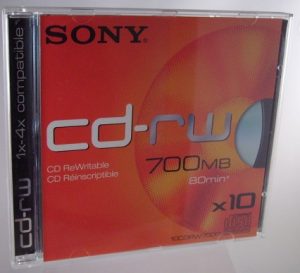History (1997): CD-RW
Rewritable optical disc based on Compact Disc
This is a Press Release edited by StorageNewsletter.com on January 4, 2019 at 2:12 pmThis article was published by the Museum of Obsolete Media.
Compact Disc-ReWritable (CD-RW) (1997-)

Compact Disc-ReWritable (CD-RW) is a rewritable optical disc format based on the Compact Disc, and introduced in 1997.
CD-RWs are based on the Orange Book standards.
Like regular Compact Discs and CD-Rs, CD-RWs are composed of a polycarbonate plastic substrate, a thin reflective metal coating, and a protective outer coating. In a CD-RW, the reflective layer is an alloy that can change back and forth from a crystalline form when exposed to the laser, through a technology called optical phase change. The patterns created are less distinct than those of other CD formats, requiring a more sensitive device for playback. Due to this, CD-RWs cannot be read in some CD-ROM drives built prior to 1997. CD-ROM drives that can read CD-RWs will be designated as MultiRead to show compatibility.
Older CD-RW drives often cannot handle newer, high speed CD-RW discs. CD-RW media rated at over 4x speed carry a ‘high-speed’ logo.
12cm CD-RW discs (8cm Mini CD-RW are also available) usually hold 74 minutes (650MB) of data, although some can hold up to 80 minutes (700MB) and, according to some reports, can be rewritten as many as 1,000 times.
With packet writing software and a compatible CD-RW drive, it’s possible to save data to a CD-RW in the same way as a floppy disk.
CD recorders (usually referred to as CD burners), were once much too expensive for the home user, but now are similar in price to CD-ROM drives.













 Subscribe to our free daily newsletter
Subscribe to our free daily newsletter
